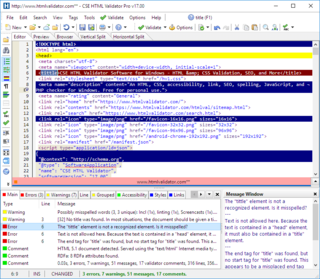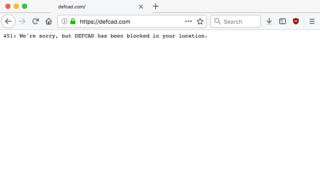Related Research Articles

Hypertext Transfer Protocol Secure (HTTPS) is an extension of the Hypertext Transfer Protocol (HTTP). It uses encryption for secure communication over a computer network, and is widely used on the Internet. In HTTPS, the communication protocol is encrypted using Transport Layer Security (TLS) or, formerly, Secure Sockets Layer (SSL). The protocol is therefore also referred to as HTTP over TLS, or HTTP over SSL.

In computer network communications, the HTTP 404, 404 not found, 404, 404 error, page not found, or file not found error message is a hypertext transfer protocol (HTTP) standard response code, to indicate that the browser was able to communicate with a given server, but the server could not find what was requested. The error may also be used when a server does not wish to disclose whether it has the requested information.
In computer technology and telecommunications, online indicates a state of connectivity and offline indicates a disconnected state. In modern terminology, this usually refers to an Internet connection, but could refer to any piece of equipment or functional unit that is connected to a larger system. Being online means that the equipment or subsystem is connected, or that it is ready for use.
Cross-site scripting (XSS) is a type of security vulnerability that can be found in some web applications. XSS attacks enable attackers to inject client-side scripts into web pages viewed by other users. A cross-site scripting vulnerability may be used by attackers to bypass access controls such as the same-origin policy. During the second half of 2007, XSSed documented 11,253 site-specific cross-site vulnerabilities, compared to 2,134 "traditional" vulnerabilities documented by Symantec. XSS effects vary in range from petty nuisance to significant security risk, depending on the sensitivity of the data handled by the vulnerable site and the nature of any security mitigation implemented by the site's owner network.

A captive portal is a web page accessed with a web browser that is displayed to newly connected users of a Wi-Fi or wired network before they are granted broader access to network resources. Captive portals are commonly used to present a landing or log-in page which may require authentication, payment, acceptance of an end-user license agreement, acceptable use policy, survey completion, or other valid credentials that both the host and user agree to adhere by. Captive portals are used for a broad range of mobile and pedestrian broadband services – including cable and commercially provided Wi-Fi and home hotspots. A captive portal can also be used to provide access to enterprise or residential wired networks, such as apartment houses, hotel rooms, and business centers.
Online advertising, also known as online marketing, Internet advertising, digital advertising or web advertising, is a form of marketing and advertising that uses the Internet to promote products and services to audiences and platform users. Online advertising includes email marketing, search engine marketing (SEM), social media marketing, many types of display advertising, and mobile advertising. Advertisements are increasingly being delivered via automated software systems operating across multiple websites, media services and platforms, known as programmatic advertising.
URL shortening is a technique on the World Wide Web in which a Uniform Resource Locator (URL) may be made substantially shorter and still direct to the required page. This is achieved by using a redirect which links to the web page that has a long URL. For example, the URL "https://example.com/assets/category_B/subcategory_C/Foo/" can be shortened to "https://example.com/Foo", and the URL "https://en.wikipedia.org/wiki/URL_shortening" can be shortened to "https://w.wiki/U". Often the redirect domain name is shorter than the original one. A friendly URL may be desired for messaging technologies that limit the number of characters in a message, for reducing the amount of typing required if the reader is copying a URL from a print source, for making it easier for a person to remember, or for the intention of a permalink. In November 2009, the shortened links of the URL shortening service Bitly were accessed 2.1 billion times.
An offline reader is computer software that downloads e-mail, newsgroup posts or web pages, making them available when the computer is offline: not connected to a server. Offline readers are useful for portable computers and dial-up access.
Svelte is a free and open-source component-based front-end software framework, and language created by Rich Harris and maintained by the Svelte core team members.
DNS hijacking, DNS poisoning, or DNS redirection is the practice of subverting the resolution of Domain Name System (DNS) queries. This can be achieved by malware that overrides a computer's TCP/IP configuration to point at a rogue DNS server under the control of an attacker, or through modifying the behaviour of a trusted DNS server so that it does not comply with internet standards.
GlobalSign is a certificate authority and a provider of internet identity and security products. As of January 2015, Globalsign was the 4th largest certificate authority in the world, according to Netcraft.

A paywall is a method of restricting access to content, with a purchase or a paid subscription, especially news. Beginning in the mid-2010s, newspapers started implementing paywalls on their websites as a way to increase revenue after years of decline in paid print readership and advertising revenue, partly due to the use of ad blockers. In academics, research papers are often subject to a paywall and are available via academic libraries that subscribe.
JSONP, or JSON-P, is a historical JavaScript technique for requesting data by loading a <script> element, which is an element intended to load ordinary JavaScript. It was proposed by Bob Ippolito in 2005. JSONP enables sharing of data bypassing same-origin policy, which disallows running JavaScript code to read media DOM elements or XMLHttpRequest data fetched from outside the page's originating site. The originating site is indicated by a combination of URI scheme, hostname, and port number.

CSS HTML Validator is an HTML editor and CSS editor for Windows that helps web developers create syntactically correct and accessible HTML/HTML5, XHTML, and CSS documents by locating errors, potential problems like browser compatibility issues, and common mistakes. It is also able to check links, check spelling, suggest improvements, alert developers to deprecated, obsolete, or proprietary tags, attributes, and CSS properties, and find issues that can affect search engine optimization.

In computer networking, HTTP 451 Unavailable For Legal Reasons is a proposed standard error status code of the HTTP protocol to be displayed when the user requests a resource which cannot be served for legal reasons, such as a web page censored by a government. The number 451 is a reference to Ray Bradbury's 1953 dystopian novel Fahrenheit 451, in which books are outlawed. 451 provides more information than HTTP 403, which is often used for the same purpose. This status code is currently a proposed standard in RFC 7725 but is not yet formally a part of HTTP, as of RFC 9110.

Google Docs is an online word processor included as part of the free, web-based Google Docs Editors suite offered by Google, which also includes Google Sheets, Google Slides, Google Drawings, Google Forms, Google Sites and Google Keep. Google Docs is accessible via an internet browser as a web-based application and is also available as a mobile app on Android and iOS and as a desktop application on Google's ChromeOS.

WebTorrent is a peer-to-peer (P2P) streaming torrent client written in JavaScript, from the same author, Feross Aboukhadijeh, of YouTube Instant, and the team at WebTorrent and on GitHub, for use in web browsers, as well as a WebTorrent Desktop stand alone version able to bridge WebTorrent and BitTorrent serverless networks.
NewsGuard is a rating system for news and information websites. It is accessible via browser extensions and mobile apps. NewsGuard Technologies Inc., the company behind the tool, also provides services such as misinformation tracking and brand safety for advertisers, search engines, social media platforms, cybersecurity firms, and government agencies.
Next.js is an open-source web development framework created by the private company Vercel providing React-based web applications with server-side rendering and static website generation.
References
- ↑ Martin, Alexander. "Paywall-breaking tool 12ft asks users to subscribe to cover costs". Sky News. Retrieved 2022-04-08.
- ↑ Shah, Saqib (2023-12-04). "What is 12ft Ladder?: popular paywall-bypassing site back online". Evening Standard. Retrieved 2023-12-06.
- ↑ Guaglione, Sara (25 August 2023). "Publishers still find it challenging to measure readers bypassing their paywalls". Digiday.
- ↑ "451: DEPLOYMENT_DISABLED". 12ft.io. Archived from the original on 31 August 2022. Retrieved 1 September 2022.
This Deployment has been disabled. Your connection is working correctly. Vercel is working correctly.
- ↑ "12ft has been disabled for this site". 12ft.io. Retrieved 2023-06-01.
- ↑ "12ft is down, @vercel banned me". X. Retrieved 2023-10-30.
- ↑ "15 Free Ways to Get Around Paywalls". All About Cookies.
- ↑ "12ft Ladder Alternatives". AlternativeTo.
- ↑ "5 Best Chrome extensions to bypass a paywall". Bardeen.ai.
- ↑ "txtify.it". txtify.it.
- ↑ "PrintFriendly".